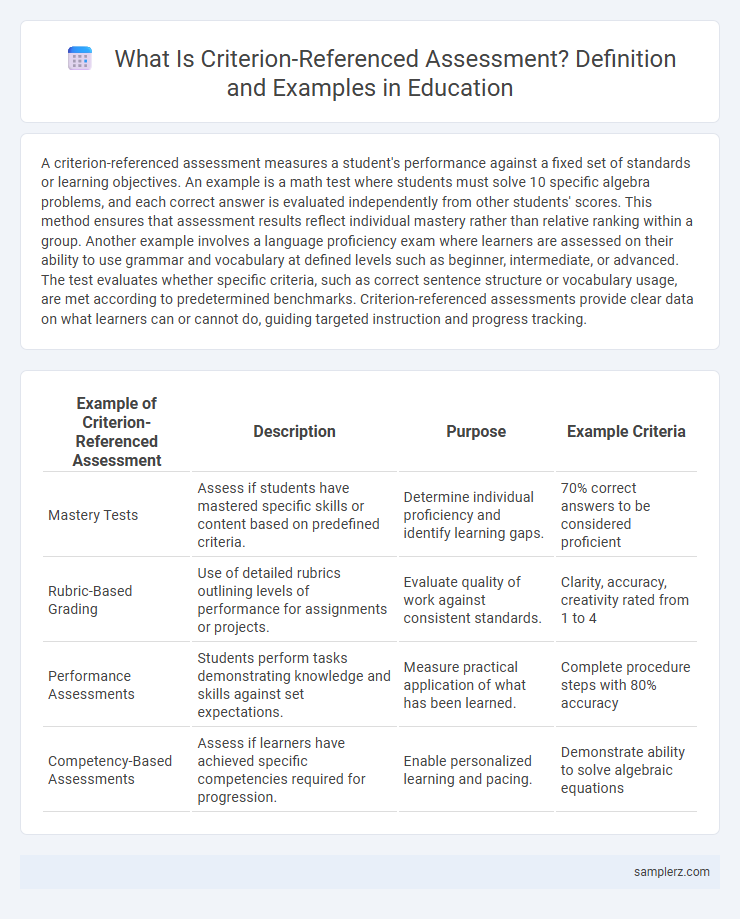A criterion-referenced assessment measures a student's performance against a fixed set of standards or learning objectives. An example is a math test where students must solve 10 specific algebra problems, and each correct answer is evaluated independently from other students' scores. This method ensures that assessment results reflect individual mastery rather than relative ranking within a group. Another example involves a language proficiency exam where learners are assessed on their ability to use grammar and vocabulary at defined levels such as beginner, intermediate, or advanced. The test evaluates whether specific criteria, such as correct sentence structure or vocabulary usage, are met according to predetermined benchmarks. Criterion-referenced assessments provide clear data on what learners can or cannot do, guiding targeted instruction and progress tracking.
Table of Comparison
| Example of Criterion-Referenced Assessment | Description | Purpose | Example Criteria |
|---|---|---|---|
| Mastery Tests | Assess if students have mastered specific skills or content based on predefined criteria. | Determine individual proficiency and identify learning gaps. | 70% correct answers to be considered proficient |
| Rubric-Based Grading | Use of detailed rubrics outlining levels of performance for assignments or projects. | Evaluate quality of work against consistent standards. | Clarity, accuracy, creativity rated from 1 to 4 |
| Performance Assessments | Students perform tasks demonstrating knowledge and skills against set expectations. | Measure practical application of what has been learned. | Complete procedure steps with 80% accuracy |
| Competency-Based Assessments | Assess if learners have achieved specific competencies required for progression. | Enable personalized learning and pacing. | Demonstrate ability to solve algebraic equations |
Defining Criterion-Referenced Assessment
Defining criterion-referenced assessment involves evaluating student performance based on predetermined learning objectives rather than comparing scores to peers. For example, a math test designed to measure mastery of fractions aligns student responses directly to specific criteria such as correctly adding or subtracting fractions with like denominators. This approach emphasizes individual achievement and ensures assessment accurately reflects students' understanding of targeted skills or knowledge.
Key Features of Criterion-Referenced Assessment
Criterion-referenced assessment evaluates student performance based on predefined learning objectives and specific criteria rather than comparing scores to peers. Key features include clear, measurable learning goals, consistent standards applied to all students, and detailed feedback that highlights strengths and areas for improvement. This approach ensures assessments align closely with instructional content and supports personalized learning paths.
Importance of Clear Learning Objectives
Clear learning objectives are essential in criterion-referenced assessment to ensure that students are evaluated against specific, predefined standards rather than relative performance. This approach allows educators to measure mastery of particular skills or knowledge areas, providing precise feedback on student progress. Establishing unambiguous criteria aligns instruction with desired outcomes, enhancing the effectiveness and fairness of assessments.
Examples of Criterion-Referenced Test Items
Criterion-referenced test items measure student performance against specific learning standards or objectives, such as multiple-choice questions that assess knowledge of key concepts like photosynthesis stages or mathematical problem-solving steps. Examples include checklist rubrics evaluating writing skills based on predefined criteria for grammar, coherence, and vocabulary use. Performance tasks like science experiments requiring students to demonstrate understanding of the scientific method also serve as effective criterion-referenced assessments.
Designing Rubrics for Criterion-Referenced Assessment
Designing rubrics for criterion-referenced assessment involves clearly defining performance standards aligned with learning objectives, enabling educators to measure students' skills against specific criteria rather than peer performance. Effective rubrics include descriptive levels of achievement for each criterion, promoting consistency and objectivity in scoring while providing detailed feedback for student improvement. This approach enhances transparency in assessment and supports targeted instructional strategies by identifying areas of strength and weakness relative to established benchmarks.
Criterion-Referenced Assessment in Classroom Practice
Criterion-referenced assessment in classroom practice evaluates student performance based on predefined learning objectives, such as mastering specific skills in math or reading fluency benchmarks. Teachers design tasks that measure whether each student meets established standards rather than comparing against peers, ensuring targeted feedback and instructional adjustment. This approach supports personalized learning by identifying individual strengths and areas needing improvement aligned with curriculum goals.
Differentiating Between Criterion-Referenced and Norm-Referenced Assessment
Criterion-referenced assessment measures student performance against specific learning objectives, such as scoring 80% or higher on a math skills test aligned with state standards. In contrast, norm-referenced assessment compares a student's performance to that of a peer group, ranking individuals on a percentile scale. Understanding these differences helps educators tailor instructional strategies to individual mastery rather than relative achievement.
Benefits of Using Criterion-Referenced Assessment
Criterion-referenced assessment evaluates student performance against predefined learning standards, offering precise insights into skill mastery and knowledge acquisition. This method enables educators to identify specific strengths and areas needing improvement, enhancing targeted instruction and personalized learning plans. Clear benchmarks facilitate consistent grading and transparent communication of student progress to stakeholders, promoting accountability and motivation.
Challenges in Implementing Criterion-Referenced Assessment
Implementing criterion-referenced assessment often faces challenges such as difficulty in defining clear, measurable criteria that align with diverse learning objectives. Teachers may struggle with ensuring consistency and objectivity in scoring when criteria are subjective or open to interpretation. Limited resources and inadequate training further hinder effective application, leading to inconsistent feedback and reduced reliability in measuring student mastery.
Enhancing Student Learning with Criterion-Based Feedback
Criterion-reference in assessment involves measuring student performance against predetermined learning objectives, such as mastery of specific skills in mathematics or understanding key concepts in biology. Providing criterion-based feedback helps students identify areas for improvement, guiding them toward meeting explicit academic standards and fostering self-regulated learning. This targeted approach enhances student learning by clarifying expectations and promoting continuous progress based on clear, measurable criteria.

example of criterion-reference in assessment Infographic
 samplerz.com
samplerz.com